Esomeprazole
 | |
 | |
| Clinical data | |
|---|---|
| Pronunciation |
/ˌɛsoʊˈmɛprəˌzoʊl, |
| Trade names | Nexium, many others[2] |
| AHFS/Drugs.com | Monograph |
| MedlinePlus | a699054 |
| License data |
|
| Pregnancy category | |
| Routes of administration | by mouth, IV |
| Drug class | proton pump inhibitor |
| ATC code | |
| Legal status | |
| Legal status |
|
| Pharmacokinetic data | |
| Bioavailability | 50 to 90% |
| Metabolism | Liver (CYP2C19, CYP3A4) |
| Elimination half-life | 1–1.5 hours |
| Excretion |
80% Kidney 20% Faecal |
| Identifiers | |
| |
| CAS Number | |
| PubChem CID | |
| DrugBank | |
| ChemSpider | |
| UNII | |
| KEGG | |
| ChEBI | |
| ChEMBL | |
| ECHA InfoCard |
100.149.303 |
| Chemical and physical data | |
| Formula | C17H19N3O3S |
| Molar mass | 345.417 g/mol |
| 3D model (JSmol) | |
| |
| |
| | |
Esomeprazole, sold under the brand names Nexium among others,[2] is a proton-pump inhibitor which reduces stomach acid. It is used in the treatment of dyspepsia, peptic ulcer disease, gastroesophageal reflux disease, and Zollinger-Ellison syndrome.
It decreases secretion of acid through inhibition of the H+/K+-ATPase in the parietal cells of the stomach. By inhibiting the functioning of this transporter, the drug prevents formation of stomach acid.
Esomeprazole is the (S)-(−)-enantiomer of omeprazole. Esomeprazole is currently sold over the counter in the US, the UK, Australia, and Canada.[3]
Medical use
The primary uses of esomeprazole are gastroesophageal reflux disease, treatment and maintenance of erosive esophagitis, treatment of duodenal ulcers caused by H. pylori, prevention of gastric ulcers in those on chronic NSAID therapy, and treatment of gastrointestinal ulcers associated with Crohn's disease.[4][5]
Gastroesophageal reflux disease
Gastroesophageal reflux disease (GERD) is a condition in which the digestive acid in the stomach comes in contact with the esophagus. The irritation caused by this disorder is known as heartburn. Long-term contact between gastric acids and the esophagus can cause permanent damage to the esophagus. Esomeprazole reduces the production of digestive acids, thus minimizing their effect on the esophagus.
Duodenal ulcers
Esomeprazole is combined with the antibiotics clarithromycin and amoxicillin (or metronidazole instead of amoxicillin in penicillin-hypersensitive patients) in a 10-day eradication triple therapy for Helicobacter pylori. Infection by H. pylori is a causative factor in the majority of peptic and duodenal ulcers.
Efficacy
A 2006 meta analysis concluded that compared to other proton pump inhibitors, esomeprazole confers a statistically significant but clinically modest overall benefit in esophageal healing and symptom relief. When broken down by disease severity, the benefit of esomeprazole relative to other proton pump inhibitors was negligible in patients with mild disease (number needed to treat 50), but appeared more substantial in those with severe disease (number needed to treat 8).[6] A second meta analysis also found statistically significant increases in erosive esophageal healing (>95% healing rate) when compared to standardized doses in broadly selected patient populations.[7]
Adverse effects
Common side effects include headache, diarrhea, nausea, flatulence, decreased appetite, constipation, dry mouth, and abdominal pain. More severe side effects are severe allergic reactions, chest pain, dark urine, fast heartbeat, fever, paresthesia, persistent sore throat, severe stomach pain, unusual bruising or bleeding, unusual tiredness, and yellowing of the eyes or skin.[8]
Proton pump inhibitors may be associated with a greater risk of hip fractures[9] and Clostridium difficile-associated diarrhoea.[10] Patients are frequently administered the drugs in intensive care as a protective measure against ulcers, but this use is also associated with a 30% increase in occurrence of pneumonia.[11]
Long-term use of PPIs in patients treated for Helicobactor pylori has been shown to dramatically increase the risk of gastric cancer.[12]
Interactions
Esomeprazole is a competitive inhibitor of the enzyme CYP2C19, and may therefore interact with drugs that depend on it for metabolism, such as diazepam and warfarin; the concentrations of these drugs may increase if they are used concomitantly with esomeprazole.[13] Conversely, clopidogrel (Plavix) is an inactive prodrug that partially depends on CYP2C19 for conversion to its active form; inhibition of CYP2C19 blocks the activation of clopidogrel, thus reducing its effects.[14][15]
Drugs that depend on stomach pH for absorption may interact with omeprazole; drugs that depend on an acidic environment (such as ketoconazole or atazanavir) will be poorly absorbed, whereas drugs that are broken down in acidic environments (such as erythromycin) will be absorbed to a greater extent than normal.[13]
Pharmacokinetics
Single 20 to 40 mg oral doses generally give rise to peak plasma esomeprazole concentrations of 0.5-1.0 mg/l within 1–4 hours, but after several days of once-daily administration, these levels may increase by about 50%. A 30-minute intravenous infusion of a similar dose usually produces peak plasma levels on the order of 1–3 mg/l. The drug is rapidly cleared from the body, largely by urinary excretion of pharmacologically inactive metabolites such as 5-hydroxymethylesomeprazole and 5-carboxyesomeprazole. Esomeprazole and its metabolites are analytically indistinguishable from omeprazole and the corresponding omeprazole metabolites unless chiral techniques are employed.[16]
Dosage forms

Esomeprazole is available as delayed-release capsules in the United States or as delayed-release tablets in Australia, the United Kingdom, and Canada (containing esomeprazole magnesium) in strengths of 20 and 40 mg, as delayed-release capsules in the United States (containing esomeprazole strontium) in a 49.3 mg strength (delivering the equivalent of 40 mg of esomeprazole,[17] and as esomeprazole sodium for intravenous injection/infusion. Oral esomeprazole preparations are enteric-coated, due to the rapid degradation of the drug in the acidic conditions of the stomach. This is achieved by formulating capsules using the multiple-unit pellet system.
The combination naproxen/esomeprazole magnesium (brand name Vimovo) is used for the prevention of gastric ulcers associated with chronic NSAID therapy. Vimovo is available in two dosage strengths: 500/20 mg and 375/20 mg. Clinical trials of naproxen/esomeprazole demonstrated an incidence of GI ulcer in 24% of patients on naproxen (alone) versus 7% on naproxen/esomeprazole.[18] The FDA has added warnings to the label for Vimovo concerning acute interstitial nephritis and risk of kidney problems in some patients.[19]
Multiple-unit pellet system
Esomeprazole capsules, as well as Losec/Prilosec tablets, are formulated as a "multiple-unit pellet system" (MUPS). Essentially, the capsule consists of extremely small enteric-coated granules (pellets) of the esomeprazole formulation inside an outer shell. When the capsule is immersed in an aqueous solution, as happens when the capsule reaches the stomach, water enters the capsule by osmosis. The contents swell from water absorption, causing the shell to burst, and releasing the enteric-coated granules. For most patients, the multiple-unit pellet system is of no advantage over conventional enteric-coated preparations. Patients for whom the formulation is of benefit include those requiring nasogastric tube feeding and those with difficulty swallowing (dysphagia).
Society and culture
Global distribution
In late 2010, AstraZeneca announced a co-promotion agreement with Daiichi Sankyo to distribute Nexium in Japan.[20] In September 2011, Nexium was approved for sale and was launched by Daiichi Sankyo in Japan.[21] Nexium is also sold online with a prescription via Nexium direct.
Economics
Between the launch of esomeprazole in 2001 and 2005, the drug has netted AstraZeneca about $14.4 billion.[22]
Controversy
There has been some controversy about AstraZeneca's behaviour in creating, patenting, and marketing of the drug. Esomeprazole's successful predecessor, omeprazole, is a mixture of two mirror-imaged molecules (esomeprazole which is the S-enantiomer, and R-omeprazole); critics said the company was trying to "evergreen" its omeprazole patent by patenting the pure esomeprazole and aggressively marketing to doctors that it is more effective than the mixture.[23]
Thomas A. Scully, head of the Centers for Medicare and Medicaid Services, also criticized AstraZeneca for their aggressive marketing of Nexium. At a conference of the American Medical Association, he said that Astra was using the new drug to overcharge consumers and insurance companies.
Brand names
Generic versions of esomeprazole magnesium are available worldwide.[2] It is available over-the-counter under the brand name Nexium in the United States[24] and in the UK.
References
- ↑ "Esomeprazole". Merriam-Webster Dictionary. Retrieved 2016-01-21.
- 1 2 3 Esomeprazole brand names
- ↑ https://www.canada.ca/en/health-canada/services/drugs-health-products/drug-products/prescription-drug-list/notice-esomeprazole-1.html
- ↑ "Esomeprazole Magnesium". The American Society of Health-System Pharmacists. Retrieved 3 April 2011.
- ↑ Li J, Zhao J, Hamer-Maansson JE, Andersson T, Fulmer R, Illueca M, Lundborg P (March 2006). "Pharmacokinetic properties of esomeprazole in adolescent patients aged 12 to 17 years with symptoms of gastroesophageal reflux disease: A randomized, open-label study". Clin Ther. 28 (3): 419–27. doi:10.1016/j.clinthera.2006.03.010. PMID 16750456.
- ↑ Gralnek IM, Dulai GS, Fennerty MB, Spiegel BM (December 2006). "Esomeprazole versus other proton pump inhibitors in erosive esophagitis: a meta-analysis of randomized clinical trials". Clin. Gastroenterol. Hepatol. 4 (12): 1452–8. doi:10.1016/j.cgh.2006.09.013. PMID 17162239.
- ↑ Edwards SJ, Lind T, Lundell L (September 2006). "Systematic review: proton pump inhibitors (PPIs) for the healing of reflux oesophagitis - a comparison of esomeprazole with other PPIs". Aliment. Pharmacol. Ther. 24 (5): 743–50. doi:10.1111/j.1365-2036.2006.03074.x. PMID 16918878.
- ↑ "Nexium side effects". Drug information online. Drugs.com. Retrieved 2009-06-23.
- ↑ Yang YX, Lewis JD, Epstein S, Metz DC (2006). "Long-term proton pump inhibitor therapy and risk of hip fracture". JAMA. 296 (24): 2947–53. doi:10.1001/jama.296.24.2947. PMID 17190895.
- ↑ "Proton pump inhibitors and Clostridium difficile". Bandolier. 2003. Archived from the original on 2012-12-23. Retrieved 2007-07-13.
- ↑ Herzig SJ, Howell MD, Ngo LH, Marcantonio ER (2009). "Acid-suppressive medication use and the risk for hospital-acquired pneumonia". JAMA. 301 (20): 2120–8. doi:10.1001/jama.2009.722. PMID 19470989.
- ↑ Cheung, Ka Shing; Chan, Esther W.; Wong, Angel Y. S.; Chen, Lijia; Wong, Ian C. K.; Leung, Wai Keung (2017-09-18). "Long-term proton pump inhibitors and risk of gastric cancer development after treatment for Helicobacter pylori: a population-based study". Gut: gutjnl–2017–314605. doi:10.1136/gutjnl-2017-314605. ISSN 0017-5749.
- 1 2 Stedman CA, Barclay ML (August 2000). "Review article: comparison of the pharmacokinetics, acid suppression and efficacy of proton pump inhibitors". Aliment. Pharmacol. Ther. 14 (8): 963–78. doi:10.1046/j.1365-2036.2000.00788.x. PMID 10930890.
- ↑ Lau WC, Gurbel PA (March 2009). "The drug-drug interaction between proton pump inhibitors and clopidogrel". CMAJ. 180 (7): 699–700. doi:10.1503/cmaj.090251. PMC 2659824. PMID 19332744.
- ↑ Norgard NB, Mathews KD, Wall GC (July 2009). "Drug-drug interaction between clopidogrel and the proton pump inhibitors". Ann Pharmacother. 43 (7): 1266–74. doi:10.1345/aph.1M051. PMID 19470853.
- ↑ R. Baselt, Disposition of Toxic Drugs and Chemicals in Man, 8th edition, Biomedical Publications, Foster City, CA, 2008, pp. 388-389.
- ↑ "esomeprazole strontium capsule, delayed release". DailyMed.
- ↑ Viomo label
- ↑ FDA Vimovo label updates
- ↑ Press Release: AstraZeneca announces co-promotion agreement with Daiichi Sankyo for NEXIUM in Japan
- ↑ "Daiichi Sankyo and AstraZeneca Launch NEXIUM(R) 10mg and 20mg Capsules in Japan". Media & Investors. Daiichi Sankyo.
- ↑ Financial impact information: 2005, $4.6 billion; 2004, $3.9 billion Archived 2007-02-02 at the Wayback Machine.; 2003, $3.3 billion Archived 2004-07-28 at the Wayback Machine.; 2002, $2 billion Archived 2003-06-08 at the Wayback Machine.; 2001, launch and $580 million.
- ↑ Gladwell, Malcolm (2004-10-25). "High Prices: How to think about prescription drugs". The New Yorker. Retrieved 2006-06-23.
- ↑ "Nonprescription Nexium Heartburn Medicine Launches". ABC News. May 27, 2014.
External links
- Nexium official site
- Details for Nexium
- Esomeprazole strontium site
- U.S. National Library of Medicine: Drug Information Portal - Esomeprazole
- ↑ Nexium [package insert]. Wilmington, DE: AstraZeneca; 2014